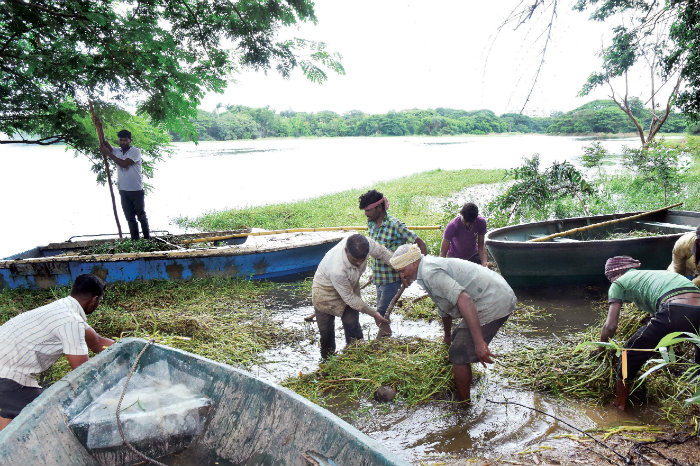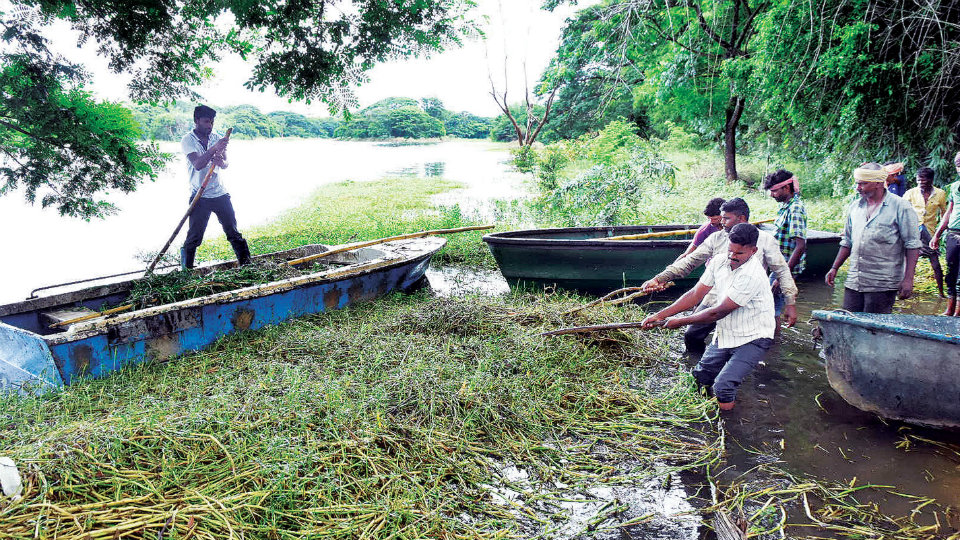Mysuru: Soon after rainwater flowing from the Chamundi Hill filled up the desilted Karanji Lake to the brim, the Zoo authorities that manage the Lake have got into the act of beautifying the Lake. A massive operation to clear the weeds and wild growth has been undertaken to prevent the growth of water hyacinth that choke the water and its living beings.
Zoo authorities said that the works will be completed within four or five days and after that the Lake will be full of clear water. Usually, the weeds grow on the sides of the Lake and dominate the water. Using a couple of boats, Zoo workers are clearing the weeds and drawing them to the shore.
Boat barriers
Once the weeds are collected, barriers are made using a couple of boats to prevent weeds from escaping back into the Lake. They are then physically pulled out to the shore from where they are disposed of.
Till recently, the Lake was bone dry and water filled up only after Oct. 5 when it rained heavily atop the Chamundi Hill. Water has filled the Lake due to constant efforts of the Zoo authorities including scientific desilting and clearing of Rajakaluves that naturally bring in water to the Lake from Chamundi Hill.
Including its garden, the Karanji Lake spans 77 acres and water will collect in 45 acres and in that 16,000 cubic metres have been desilted using the scientific ‘Drawdown Method’ to facilitate collection of more water.

Preserving natural environment
In order to preserve the natural environment that plays host to a variety of aquatic and bird species silt was not removed on the side of Lalitha Mahal Road (Rana Pratap Circle), Nazarbad and Regional Museum of Natural History side and watch tower) towards Vinaya Marga near Siddhartha Layout. But the entire area is dominated by water hyacinth, invasive vines.
Though there were many fish species that had taken shelter in this area, due to wild growth and decay, foul smell was emanating from here. The wild growth had covered the Lake as a thick blanket and water was not visible.
Intertwined weeds
Over 8 to 10 workers, armed with rowing boats, shovels and other drawing equipment are engaged in cleaning the Lake. Due to many years of growth, the wild vines are intertwined with each other, making it a Herculean task to remove manually.
Following complaints from the public that some areas of Karanji Lake stinks, Zoo authorities have clarified that the smell will remain for a month or so and no polluted water is entering the Lake from the surrounding areas. Zoo Executive Director Ajit M. Kulkarni told Star of Mysore that the smell is due to the decaying of wild weeds and invasive vines. “The decayed material is consumed by fish and other organisms. Also, we have started clearing the weeds now. The smell will be eradicated within a month,” he said.
Broken manhole
“As people complained of bad smell, we discovered that a manhole had broken on the Rajakaluve that brings fresh water from the Chamundi Hill. Immediately, the Mysuru City Corporation authorities were alerted and the manhole was repaired. There is no sewage flow now,” Kulkarni added.
Member-Secretary to Zoo Authority of Karnataka B.P. Ravi told Star of Mysore that the entire weed population is not cleared as there are living organisms that depend on weeds for food. “Only selected areas and selected weeds are removed. If there is fresh water in the Lake, lotus blooms and if the water is polluted, there will be Eichhornia or water hyacinth growth,” Ravi added.
By M.T. Yogesh Kumar








Recent Comments